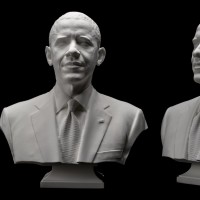Up close and personal with POTUS
When you think of presidential portraits, the famous Lansdowne portrait of George Washington comes to mind—a steely-eyed statesman painted in oils amid the regalia of his office. But modern times call for modern methods of capturing the presidential likeness. For the very first time, digital 3-D scans have been used to create portraits of President Barack Obama, now on display in the Smithsonian Castle. The portraits of President Obama were created by a Smithsonian-led team of 3-D digital imaging specialists and include a digital and 3-D printed bust and life mask. A new video released today by the White House details the behind-the-scenes process of scanning, creating and printing the historic portraits.
The Smithsonian-led team scanned the President earlier this year using two distinct 3-D documentation processes. Experts from the University of Southern California’s Institute for Creative Technologies used their Light Stage face scanner to document the President’s face from ear to ear in high resolution. Next, a Smithsonian team used handheld 3-D scanners and traditional single-lens reflex cameras to record peripheral 3-D data to create an accurate bust.
The data captured was post-processed by 3-D graphics experts at the software company Autodesk to create final high-resolution models. The life mask and bust were then printed using 3D Systems’ Selective Laser Sintering printers.
The data and the printed models are part of the collection of the Smithsonian’s National Portrait Gallery. The life-mask scan of Obama joins only three other presidential life masks in the Portrait Gallery’s collection: one of George Washington created by Jean-Antoine Houdon and two of Abraham Lincoln created by Leonard Wells Volk (1860) and Clark Mills (1865). The Washington and Lincoln life masks were created using traditional plaster-casting methods. The Lincoln life masks are currently available to explore and download on the Smithsonian’s X 3D website.
3-D–printed bust of President Obama created by the Smithsonian using 3-D scanning technology
- A 3-D printed bust of President Barack Obama is the first presidential portrait created using 3-D technology. The prints and the 3-D data are now part of the collection of the National Portrait Gallery.
Posted: 2 December 2014
-
Categories:
Art and Design , Collaboration , Feature Stories , History and Culture , News & Announcements , Portrait Gallery






